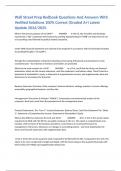Exam (elaborations)
Wall Street Prep Redbook Questions And Answers With Verified Solutions 100% Correct (Graded A+) Latest Update 2024/2025.
- Course
- Institution
Wall Street Prep Redbook Questions And Answers With Verified Solutions 100% Correct (Graded A+) Latest Update 2024/2025.
[Show more]




